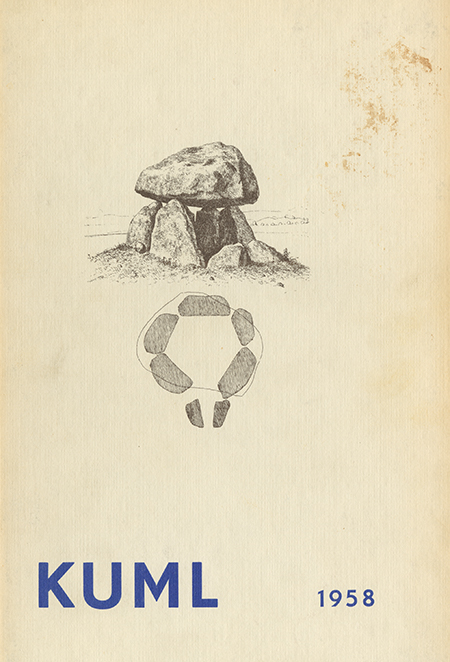Rekognoscering i Abu Dhabi
DOI:
https://doi.org/10.7146/kuml.v8i8.102775Keywords:
Abu Dhabi, Umm an-Nar, reconnaissance, rekognosceringAbstract
Reconnaissance in Abu Dhabi
In the spring of 1958 the opportunity arose to extend the area along the northeast coast of Arabia which Danish archeologists have been investigating since 1953 to Abu Dhabi on the western side of the Oman peninsula. An invitation from the Ruler of that region, His Highness Sheikh Shakhbut bin Sultan bin Zaid, was conveyed to us by our friend of many year's standing, Temple Hillyard, the representative of the Abu Dhabi Marine Areas Limited in Abu Dhabi, who extended to us the hospitality of his home, while his Company, through the good offices of Lewis, its Manager in Bahrain, provided passages to and from the mainland. The reconnaissance, which was carried out by T. Hillyard, T. G. Bibby and the writer in the period 8-11th March, covered in particular the island of Umm an-Nar, "The Mother of Fire", where His Highness Sheikh Shakhbut desired certain ancient monuments inspected, and where Hillyard had found, shortly before our visit, a large number of stone tumuli.
Abu Dhabi is the largest and at the same time the most desolate of a series of small states on the northwest side of the Oman peninsula. It stretches from Jabal Ali in the east to the foot of the Qatar peninsula in the west, a strech of coast along the Persian Gulf of about 400 kms., and in addition extends inland to a depth of about 150 kms., including the scattered villages and oases of Liwa and a part of the fertile oasis of Buraimi, two areas which are governed respectively by two brothers of the Ruler, Sheikhs Hazaa and Zaid. No natural frontiers define the extent of the sheikhdom, but the Beduin tribes know and recognise its extent. In addition it includes a number of islands along the coast and out in the Gulf, the most important of which are Das, Ardhana, Zirko, Sir Bani Yas and Dalma. H. H. Sheikh Shakhbut's residence lies in the capital, Abu Dhabi, (Fig. 1) the largest town in the area, with 15-20.000 inhabitants, a number which cannot be established more precisely, as it fluctuates with the wanderings of the Beduin.
Desolate and windswept the open coasts of Abu Dhabi face out to the Gulf, without fresh-water springs and with only scattered palm trees around the capital. Wide stretches of salt marsh connect low weathered sandstone islands with the mainland, seamed with narrow inlets which give excellent fishing. Among the more distant islands lie the large oyster beds, where pearl fishing, previously a good source of income for the population of Abu Dhabi, is carried on in the summer months. An open harbour protected by reefs has made of the town a trading centre, visited by camel caravans from the interior 1).
Umm an-Nar is a smaller island, low and rocky, lying some 20 kms. from the town of Abu Dhabi, separated from the mainland by a narrow channel and by wide salt flats, sheltered from the sea by other islands and by the long sand-spit on which the capital stands. On Umm an-Nar there are about 40 burial mounds, all of them heaped-up cairns of quarried stone, and the greater part of them lying on the ridge to the east of the island, where a single palm-tree beside a recently built rainwater cistern is the only tall growth on the island. It is possible that a spring was to be found here in prehistoric times. The majority of the cairns are quite small, measuring ½-3/4 meters in heights and 3-5 meters in diameter. Some, however, are somewhat larger, and four, lying close together, are about 2 meters high and about 18 meters in diameter (Fig. 2). These larger cairns, which resemble some of the burial mounds near Umm al-Ma in Qatar 2) and in the most southeasterly of the tumulus fields in Bahrain, that near Mattala, were originally footed with a ring-wall of carefully shaped limestone slabs, but the greater part of these has now been broken up and carried off. The surviving ring-wall stones vary between 0.5 and 1.5 meters in length, are 0.4 meters high and are accurately cut on the outer face so as to fit together to form an unbroken circle around the mounds (Fig. 3). In this respect they also resemble a single burial mound in Bahrain near the Budaia road, which is similarly surrounded by an outer ring-wall of Jidah Limestone.
South of the ridge bearing the largest tumuli, and out towards the narrow channel which divides the island from the mainland, lies a settlement site, 2-300 meters in length and less than half as broad. Here there are signs of recent settlement, which possibly cover the ruins of a settlement contemporary with the grave-mounds. The date of these can only be determined by excavation.
On the surface of the island there is a great deal of natural brown flint. It is possible that this flint was at one time collected for use in flint-and-steel, and thereby has given the island the name of "Mother of Fire". At some points, however, particularly on the terrace around the western cairns, flint of another colour is found, a blue chalk flint, and this flint shows traces of working. Only flakes and blades have as yet been found, so that no date can be given to this culture either. However, H. H. Sheikh Shakhbut is very interested in the prospect of excavating and investigating these various sites, and we hope to be able to put such a campaign into effect in the spring of 1959.
P.V. Glob.
Downloads
Published
How to Cite
Issue
Section
License
Fra og med årgang 2022 er artikler udgivet i Kuml med en licens fra Creative Commons (CC BY-NC-SA 4.0).
Alle tidligere årgange af tidsskriftet er ikke udgivet med en licens fra Creative Commons.


